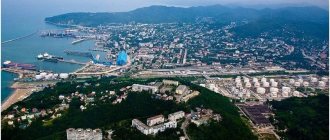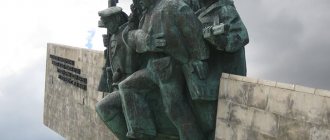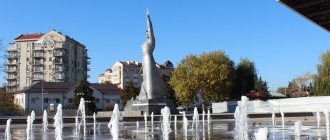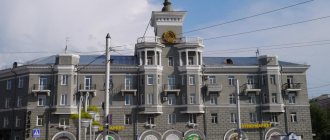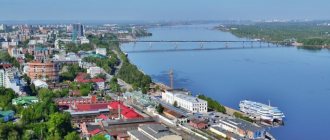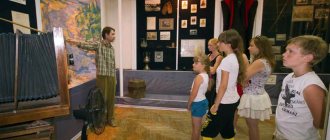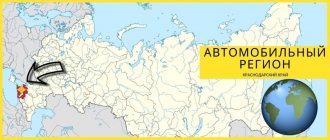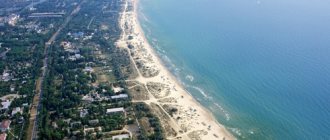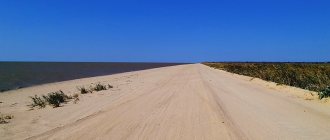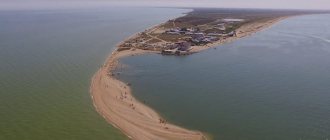Prices for food and essentials
Belorechensk has a huge number of grocery stores and markets.
In addition to goods from large manufacturers, here you can purchase products grown on your own plot. There is a large wholesale market 1 km from the city, where you can buy vegetables and fruits several times cheaper than in a store. Approximate cost of food in Belorechensk:
| name of products | cost in rub. |
| oranges | 58 per piece |
| mutton | 190 per kg |
| loaf | 18 per piece |
| vermicelli | 22 per kg |
| beef | 324 per kg |
| peas | 22 per kg |
| cabbage | 22 per kg |
| potato | 11 per kg |
| kefir | 18 per liter |
| smoked sausage | 195 per kg |
| buckwheat | 19 per kg |
| pasta | 29 per kg |
| tangerines | 72 per kg |
| sunflower oil | 130 per liter |
| butter | 25 for 200 gr. |
| milk | 32 per liter |
| carrot | 14 per kg |
| wheat flour | 18 per kg |
| mutton | 231 per kg |
| cucumbers | 54 per kg |
| rice | 32 per kg |
| frozen fish (chum salmon) | 180 per kg |
| sugar | 22 per kg |
| sour cream | 29 per kg |
| salt | 14 per kg |
| sausages | 130 per kg |
| dried fruits | 120 per kg |
| cheese | 223 per kg |
| cottage cheese | 90 per kg |
| chilled chicken | 108 per kg |
| turkey fillet | 180 per kg |
| bread | 14 per piece |
| chocolate | 40 per tile |
| sprats | 54 per can |
| apples | 31 per kg |
Advantages
Each person has an individual perception of the environment and special requirements for the place of residence.
The advantages of the city of Belorechensk include:
- A small area of a populated area.
- Modern infrastructure.
- A huge number of green spaces in the village.
- Small number of cars and lack of traffic jams.
- Hospitable local people.
- Proximity to mountains, lakes, rivers and forest belts.
- Numerous healing springs.
- Fresh air.
- Natural products grown in personal plots.
- Little crime.
Historical facts
Natural attractions of the Krasnodar region
At a place located 80 km from Krasnodar, 27 km from Maykop, there was a Circassian settlement called Shithala (“Drowning Horses”). In 1862, they built a fortress, next to which three Cossack villages were formed (Pshekhskaya, Belorechenskaya, Gurianskaya).
The good climatic conditions of the interfluve valley (the Laba and Belaya rivers) and the characteristics of the hardworking population made it possible to make them rich and attract new residents.
The emerging railway (Armavir-Tuapse) contributed to the development of local settlements.
In 1924, the settlement acquired the status of a city, a regional center. The legal name of the city of Belorechensk was born in May 1958.
In 1979, it began to be classified as a city of regional subordination. It has a new hydroelectric power station, plants and factories have been built, and a convenient infrastructure has been created for city residents. Conditions for recreation have been created in numerous parks; shops and cafes are located on the streets (their number is the largest per number of inhabitants among the cities of the Krasnodar Territory).
Position
Why is the city of Belorechensk (Krasnodar Territory) so attractive to people? Reviews from Muscovites who moved here are related to its unique location. It is located between the Belaya and Laba rivers, in a fertile valley of the North Caucasus mountain range.
In the 19th century, the Kuban Cossacks built a fortress here and founded the villages of Guriyskaya, Belorechenskaya, and Pshekhskaya. What is currently attractive for living in the city of Belorechensk (Krasnodar Territory)? Feedback from citizens who moved here agree that this area has many resources that allow them to conduct their own agriculture.
It was the rich natural resources that contributed to the rapid development of the region. In just a few years, a fortress was built here to protect the settlement from enemy invasion. And now the villages are constantly growing; the city of Belorechensk (Krasnodar Territory) has also increased significantly over the years. Reviews from people who have moved for permanent residence from other regions agree that living here is much more comfortable and cheaper than in the capital.
Map
| Belorechensk: maps |
Avito Belorechensk real estate
Belorechensk: photo from space (Google Maps) Belorechensk: photo from space (Microsoft Virtual Earth)
| Belorechensk. Nearest cities. Distances in km. on the map (in brackets along roads) + direction. Using the hyperlink in the distance , you can get the route (information courtesy of the AutoTransInfo website) | |||
| 1 | Pshekhskaya | 9 () | SW |
| 2 | Khanskaya (Republic of Adygea) | 11 () | SE |
| 3 | Giaginskaya (Republic of Adygea) | 18 (24) | NE |
| 4 | Great | 21 () | NW |
| 5 | Maykop | 24 (29) | SE |
| 6 | Krasnooktyabrsky (Republic of Adygea) | 26 () | SE |
| 7 | Ryazan | 31 () | NW |
| 8 | Apsheronsk | 35 (40) | YU |
| 9 | Tula (Republic of Adygea) | 36 (40) | SE |
| 10 | Khakurinokhabl (Republic of Adygea) | 39 () | NE |
| 11 | Dondukovskaya (Republic of Adygea) | 39 (45) | IN |
| 12 | Ponezhukay (Republic of Adygea) | 41 (93) | Z |
| 13 | Khadyzhensk | 46 (62) | SW |
| 14 | Neftegorsk | 47 () | YU |
| 15 | Krasnogvardeyskoe (Republic of Adygea) | 47 () | NW |
| 16 | Yaroslavskaya | 49 () | IN |
| 17 | Temirgoevskaya | 50 () | NE |
| 18 | Koshekhabl (Republic of Adygea) | 50 (64) | IN |
| 19 | Ust-Labinsk | 52 (57) | WITH |
| 20 | Vasyurinskaya | 53 (118) | NW |
| 21 | Saratovskaya | 53 (67) | Z |
| 22 | Voronezh | 55 (63) | NW |
| 23 | Starokorsunskaya | 55 (92) | NW |
| 24 | Petropavlovskaya | 56 () | NE |
| 25 | Dvubratsky | 56 () | WITH |
| 26 | Adygeisk | 56 (75) | Z |
| 27 | Kamennomostsky (Republic of Adygea) | 57 (66) | SE |
| 28 | Kurganinsk | 57 (72) | IN |
| 29 | Lenin | 59 () | NW |
| 30 | Ladoga | 60 (82) | WITH |
a brief description of
Located on the river. Belaya (left tributary of the Kuban), at its exit from the Greater Caucasus Mountains to the Kuban-Priazovskaya (Prikubanskaya) lowland, 95 km southeast of Krasnodar. Railway node (Belorechskaya).
Velikovechnenskaya fluoride mineral water. Balneoclimatic resort area Velikovechnoye.
Territory (sq. km): 34
Historical sketch
Founded in 1863 (1862?) as a Cossack fortress, later Belorechenskaya village; name by location on the river White. The city of Belorechensk since 1958
Economy
Enterprises of the food-flavoring industry: an oil extraction plant - the only one in Russia that processes castor oil for the production of castor oil, a dairy plant, a food processing plant, etc. Woodworking industry: a furniture factory, a lumber mill. Factories: for the production of phosphate mineral fertilizers, 2 brick. Production of building materials, etc.
In the Belorechensky district there is one of the hydroelectric power stations of the Belorechensky cascade.
For a long time, the region's agriculture was focused on the supply of milk, meat and vegetables to the city of Sochi, which determined its specialization. They grow wheat, barley, corn, rice, sunflowers, rapeseed, sugar beets, tobacco, and vegetables (tomatoes, cucumbers, cabbage, sweet peppers). Production of seeds of many vegetable crops. Dairy and beef cattle breeding, pig farming, poultry farming.
Deposits of sand and gravel mixtures.
CHEMICAL INDUSTRY
JSC "Minudobreniya" Offers:
Universities of the city
Adyghe State University (Belorechensk branch) Institute of Economics and Management in Medicine and Social Sphere (Belorechensk branch)
Architecture, sights
Near Belorechensk - Belorechensky burial mounds (burials of local nobility and warriors with their families, 14th century).
| Population by year (thousands of inhabitants) | |||||||
| 1939 | 19.8 | 1996 | 60 | 2007 | 54.0 | 2015 | 52.3 |
| 1959 | 35.9 | 1998 | 55.3 | 2008 | 54.1 | 2016 | 52.2 |
| 1967 | 42 | 2000 | 55.3 | 2010 | 54.1 | 2017 | 52.3 |
| 1970 | 36.0 | 2001 | 55.5 | 2011 | 53.9 | 2018 | 52.1 |
| 1979 | 43.0 | 2003 | 54.0 | 2012 | 53.4 | 2019 | 51.9 |
| 1989 | 51.2 | 2005 | 53.9 | 2013 | 53.0 | 2020 | 51.6 |
| 1992 | 52.3 | 2006 | 54.0 | 2014 | 52.6 |
Literature
- Pospelov E.M.
Geographical names of the world: Toponymic dictionary: About 5000 units. M.: Russian dictionaries, Astrel Publishing House LLC, AST Publishing House LLC, 2001. p. 62 - Ch.
ed. Gorkin A.P. Geography of Russia: encyclopedic dictionary. M.: Great Russian Encyclopedia, 1998. pp. 70-71 - Ch.
ed. Lappo G.M. Cities of Russia: encyclopedia. M.: Great Russian Encyclopedia, 1994. p. 45
Religion
Holy Intercession Church
The capital of the Altai region, Barnaul: description of the city, population, attractions
Holy Intercession Church
In 1863, through the diligence of parishioners, a prayer house was opened in the village. In 1881, with an allowance from the Kuban Cossack Army of 10,000 rubles, with the addition of funds from parishioners, a wooden Intercession Church with a bell tower was built in the village on a stone foundation. Consecrated on September 20, 1881. As of 1910, the clergy consisted of 2 priests, 1 deacon, 2 psalm-readers. The area of the clergy land is 172.5 dessiatines. The first priest was paid 200 rubles 70 kopecks as a military salary, psalm-readers 51 rubles 42 kopecks. At the temple there were one-class and two-class ministerial schools, men's and women's parochial schools, located in their own brick buildings. In 1934, the church building, located on the territory of modern Victory Park, was blown up.
In memory of the first village church, the Holy Protection parish was revived in Belorechensk in 1995. In 1997, by decision of the city Council of Deputies, the building of the children's cinema "Yunost", located on 60 Let VLKSM Street (now Shalimova Street), was transferred to the parish community for free use as a church. With the blessing of Metropolitan Isidore of Kuban and Ekaterinodar, in 2000 the temple was completely reconstructed and crowned with a golden dome.
Holy Dormition Church
Holy Dormition Church
In 1892, with an allowance from the Holy Synod of 3,000 rubles, the United Faith Assumption Church, wooden on a stone foundation, was built. Consecrated on November 1, 1892. In 1905, 2 side-chapels were added. As of 1910, the clergy consisted of 1 priest and 1 psalm-reader. The area of the clergy land is 60 acres. The Synodal salary for the priest is 300 rubles, for the psalm-reader 120 rubles. The church had a literacy school located in a separate brick building. The church ceased to exist in the 1920s and 1930s. The first location of the temple remains unknown.
During the Great Patriotic War, the Holy Dormition Church resumed its existence, located in one of the private houses on Klubnaya Street (later 60 Let Komsomol Street, now Shalimova Street). The Holy Intercession Church in the village of Chernigov donated a throne, an altar, church utensils, and liturgical books to the temple.
In 1955, the church moved to a house on Tolstoy Street, purchased with funds from believers. For several decades, parishioners carried out repair and construction work, the area of the temple was expanded, and in 1986 the adobe walls were lined with bricks. In 2008-2010, with the blessing of Metropolitan Isidore of Kuban and Ekaterinodar, the temple was completely reconstructed.
Currently, the colorful Church of the Assumption of the Blessed Virgin Mary is one of the main attractions of Belorechensk.
Armenian Apostolic Church
On June 6, 2015, on the memorable Day of the extraction of St. Gregory the Illuminator from the ditch (Khor Virap), the Armenian Apostolic Church of Gregory the Illuminator was opened in Belorechensk. A day earlier, the consecration of the interior of the church took place.
At the opening ceremony, the head of the diocese of the South of Russia of the Armenian Apostolic Church, Bishop Movses Movsesyan, as well as the clergy of the diocese and the rectors of existing Armenian churches in the Krasnodar region were met at the open gates of the church by the main philanthropist of the church Engels Palyan, the chairman of the Church-Parish Council Gevorg Paronyan and the chairman of the local branch of the Union of Armenians of Russia Ruben Madelyan.
The Church of Gregory the Illuminator was built according to strict Armenian Christian canons: interior design, church decoration and church area. The sculptural volumes of the temple are based on the traditions of classical Armenian architecture. The church building is located on a stylobate, which is a traditional stone foundation characteristic of church architecture in Armenia. In the interior painting of the church, the traditional canons and national color of the design of the Armenian church are preserved.
On the territory of the church there is a memorial in honor of the 100th anniversary of the Armenian genocide, depicted in the form of a grieving woman with a baby in her arms, as well as busts of the national hero of Armenia Andranik Ozanyan and the Russian commander Ivan Paskevich.
Famous Belorechensk monuments and sculptures
The history of the city, military exploits and cultural features are captured in memorable compositions, many of which are of a memorial nature.
Monument to soldiers who died in local conflicts
- Address: Lenin street.
A monument to the Belorechensk residents who died in the hot spots of Afghanistan and Chechnya was erected in the Afghans' Park. The monument represents the figure of a grieving mother located inside an exploding bullet.
The pedestal is made in the form of a round platform made of red granite. Two slabs of mourning black color are mounted into it, on which are engraved the names of the fallen internationalist soldiers, whose small homeland was Belorechensk.
Monument to firefighters killed in the line of duty in peace and war
- Address: Afghansev Square.
In April 2014, another memorial was opened in Afghans Square - a monument to firefighters. The idea of creating the monument belonged to firefighting veteran G.D. Ben-Ohanyan.
On a black slab, shaped like three tongues of flame, is engraved a drawing by artist Maria Sokolova, depicting a firefighter holding a child.
The grand opening of the monument was attended by veteran rescuers, the city administration, clergy, as well as relatives of firefighters who died in the line of duty.
Monument to Chernobyl victims
- Address: corner of Kirov and Lenin streets.
The monument in honor of the liquidators of the disaster at the Chernobyl nuclear power plant was erected in 2011. It is a granite stele, the central part of which is occupied by an icon with an inscription calling on passers-by to stop for a moment and remember the feat of the Belorechensk people who sacrificed their lives and health while providing assistance to the victims of the 1986 man-made disaster.
Victory Park
- Address: corner of Krasnaya and Taman Armiya streets.
The large-scale memorial complex, opened in 1980, includes several memorable compositions:
- Memorial "Eternal Flame". The central part of the composition is a granite pedestal on which two soldiers stand side by side: one of them is a participant in the Civil War, the other is a soldier of the Great Patriotic War. The Eternal Flame burns in front of the sculpture, and behind it there are stone slabs with bas-relief images and engraved names of Belorechensk heroes who died in the battles of the Second World War.
- In the early 2000s, a T-34 tank monument was inaugurated in Victory Park. The combat vehicle is mounted on a pedestal made of white stone with a ribbon of black granite. The monument is dedicated to tank soldiers of the Great Patriotic War.
- Intercession Chapel. The chapel was built and consecrated in 1981. It is located on the territory of Victory Park and is a tribute to the memory of the Holy Intercession Church, which was located here until 1934. The chapel has the shape of a pillar. The facades are decorated with through holes in the form of crosses, as well as framing arcs. The composition is completed by a golden dome.
- The Walk of Fame features stone busts of military leaders and heroes of the Soviet Union, including Vasilevsky A.M., Kuznetsov N.G., Bagramyan I.Kh., Rokossovsky K.K., Margelov V.F., Zhukov G.K.
Victory Park is a significant memorial and historical center of Belorechensk and a venue for ceremonial events of a military-patriotic nature.
Monument to students and teachers who died during the Second World War
- Address: st. Sverdlova, 1.
The memorial is located on the territory of school No. 68. It depicts a fighter in military uniform with a banner in his hand. His head is lowered, his face is hidden by the visor of an army helmet - the sculptor used this artistic technique to make the viewer think that the soldier could be either an elderly man (teacher) or a young man who was sitting at a school desk just yesterday.
Monument "Anchor"
- Address: st. Lenina, 64.
An unusual historical monument is located in the park of Lenin Street. This is a sea anchor, entangled in a harsh chain. In 2016, the anchor was donated to the city by the commander of the Black Sea Fleet A.V. Vitko and presented by deputy K.F. Zatulin and Rear Admiral V.E. Solovyov. Such a gift is a symbol of trust and carries a wish for peace and sustainability in life.
Bust of Kondratenko N.I.
- Address: Central Square.
Kondratenko Nikolai Ignatievich is a native of the Krasnodar region, who became a famous political figure. In 2015, as part of the City Day celebrations, a monument to Kondratenko was unveiled in Belorechensk. The stone bust is mounted on a granite pedestal with brackets.
Monument to Valentina Tolkunova
- Address: Lenin street.
Soviet and Russian singer Valentina Tolkunova was born into a family of railway workers who worked at the Belorechenskaya station. The future singer spent her early childhood years in this city.
In 2011, a sculpture of Valentina was installed in front of the house where the Tolkunov family lived. The singer is depicted in a long concert dress, and a spring flows at her bare feet, which symbolizes the purity of her voice and soul.
Writers Alley
- Address: Sverdlova, 1.
One of the oldest sculptural ensembles in Belorechensk was created in 1960. It is an alley of stone busts of famous Russian writers and poets. There are monuments to L.N. Tolstoy, A.P. Chekhov, A.S. Pushkin, M.Yu. Lermontov, A.M. Gorky and V.M. Mayakovsky. Currently, the memorial alley is recognized as a cultural heritage site and is awaiting restoration.
Authorities
The charter of the Belorechensky urban settlement of the Belorechensky district establishes the following local government bodies:
- Council of the Belorechensky urban settlement
- Head of the Belorechensky urban settlement
- Administration of Belorechensky urban settlement
Council of the Belorechensky urban settlement The Council of the Belorechensky urban settlement is a representative body of government. The Council consists of 35 deputies elected by voting. The term of office of the Settlement Council is 5 years.
On October 23, 2005, elections of deputies of the Council of the first convocation were held. On October 11, 2009, elections of deputies of the Council of the second convocation took place. On September 14, 2014, elections of deputies of the Council of the third convocation took place.
Head of the Belorechensky urban settlement
The head of the Belorechensky urban settlement heads the administration of the settlement. Since the formation of the settlement in 2004, the election of the head has been carried out on the basis of universal suffrage.
On October 23, 2005, elections for the first head of the urban settlement took place. He was elected Sergei Feliksovich Muratov, who received 54% of the votes. On October 11, 2009, the second election of the head of the urban settlement took place. Tatyana Vladimirovna Glazunova won, gaining 81.04% of the votes. The former city mayor, Sergei Muratov, was not allowed to participate in the elections. On July 17, 2013, Tatyana Glazunova resigned early as head of the city. On December 1, 2013, early elections of the head of the Belorechensky urban settlement took place. The victory was won by Yuri Vitalievich Fesenko, who received 52.17% of the votes.
In accordance with the law of the Krasnodar Territory of March 26, 2015 N 3147-KZ, the election of the head of an urban settlement on the basis of universal suffrage is canceled, and elections are held by secret ballot of the settlement Council for a period of 5 years. The expiration date of the term of office of the current head of the Belorechensky urban settlement Yuri Vitalievich Fesenko is September 9, 2018.
On December 26, 2022, Yuriy Fesenko resigned early as head of the city settlement. By the decision of the 40th session of the 3rd convocation of the Council of the Belorechensk urban settlement dated March 6, 2022, Alexander Nikolaevich Shapovalov was elected head of the city of Belorechensk.
Administration of Belorechensky urban settlement
The administration of the Belorechensky urban settlement, which is the executive and administrative body of government. The structure of the administration is made up of the head of the settlement, his deputies, as well as sectoral and territorial bodies of the local administration.
Climate and weather conditions
Belorechensk in the Krasnodar Territory (reviews from those who moved for permanent residence leave a favorable impression of the city) is located in a zone of temperate and mild climate. The city is located next to the Black Sea, so the average temperature in summer is +23°C.
Average temperature indicators calculated taking into account the last few years:
| month | day °C | night °С | comfort rating on a 5-point scale |
| January | +4,1 | -1,4 | 4,2 |
| February | +6,7 | -0,1 | 4,2 |
| March | +10,6 | +2,7 | 4,5 |
| April | +17,1 | +6,1 | 4,6 |
| May | +22,0 | +11,4 | 4,8 |
| June | +26,5 | +15,4 | 4,5 |
| July | +29,8 | +18,1 | 4,4 |
| August | +30,8 | +17,9 | 4,2 |
| September | +25,1 | +13,6 | 4,9 |
| October | +18,0 | +8,5 | 4,8 |
| november | +11,5 | +4,4 | 4,5 |
| December | +6,8 | +0,9 | 4,2 |
According to the comfort rating, the most successful months for traveling to the city of Belorechensk are September, October and May.
Average climatic conditions:
| month | sunny days | precipitation in mm | wind speed in m/s | rainy days |
| January | 9 | 38,11 | 3,4 | 13 |
| February | 11 | 26,79 | 3,8 | 9 |
| March | 12 | 36,91 | 4,1 | 15 |
| April | 17 | 28,09 | 4,0 | 12 |
| May | 18 | 64,10 | 3,1 | 20 |
| June | 24 | 58,45 | 3,0 | 17 |
| July | 27 | 43,68 | 2,9 | 16 |
| August | 29 | 29,12 | 3,4 | 10 |
| September | 25 | 36,00 | 3,4 | 11 |
| October | 22 | 43,23 | 3,6 | 10 |
| november | 14 | 33,13 | 3,3 | 9 |
| December | 12 | 37,67 | 3,4 | 13 |
Routes on the map of Belorechensk. Transport infrastructure
You can get to the city by rail and bus routes. Long-distance trains in the directions Adler-Novosibirsk, Kislovodsk, Vladikavkaz, and other important federal railway routes stop here.
Buses pass Maykop-Gelendzhik, Krasnodar, Temryuk-Labinsk. Local electric trains operate in many directions.
Getting around the city is carried out by buses, trolleybuses, and taxis. A map of Belorechensk with streets makes it possible to find the desired route. Now 53 transport companies in the city serve the needs of the population of Belorechensk.
Sights and main streets of the city of Belorechensk
The city structure includes 236 streets. Among them are beautiful names: Veselaya and Biryusinka streets. Pervomaiskaya, Pobeda, Mira, Lenin, Gagarin streets, etc. On these streets there are kindergartens, schools, museums, entertainment, and 29 libraries. The information is on the map of Belorechensk with houses.
On the main streets (there are monuments to heroes who distinguished themselves in defending the city during various military battles). There are 16 houses on Pobeda Street. It runs next to Pervomaiskaya streets, starting near Kirov and Zheleznodorozhnaya streets. The city bus station building is located on Lenin Street. Along the streets of Gagarin. Suvorov is easy to walk to the Gregorian Church of the city.
On the central square (part of Lenin Street) stands an obelisk, which has become a popular landmark of Belorechensk. Around the city, over 120 mounds were discovered, containing burials and household items of many generations of Scythians, Polovtsians, Sarmatians, Tatar-Mongols of the ancient ancestors of modern Circassians.
The local history museum has a huge collection of found objects (including jewelry made of silver, platinum, and gold). Inside the museum, an ancient dwelling in the form of a Cossack hut with all the elements of everyday life is reproduced. Many archaeological finds from local mounds adorn the museum halls of the Hermitage and Moscow museums. Popular attractions in the city include the following:
- Holy Assumption Church. The church was built in 1892. Now (2010) it stands on Tolstoy Street, completely restored, and is the main church of Belorechensk.
- Armenian Apostolic Church. It opened in 2015 on June 6 at 1 Zheleznodorozhnaya Street. On this day, Saint Gregory the Illuminator was extracted from the ditch. The architectural style of the building is made in the spirit of the strict customs of Christian Armenians. The traditions of classical Armenian architecture are visible in the sculptural decorations of the church. Nearby there is a memorial with the figure of a grieving Armenian woman with a baby.
Cultural centers of Belorechensk: where to go for guests
An acquaintance with Belorechensk will not be complete without paying attention to its cultural values. Music, dance, antiques and works of art have preserved the flavor of the now defunct Cossack village.
Museum of History and Local Lore named after V.S. Mironova
- Address: st. 40 Let October, 18.
The museum was founded in the early 1980s. Its exposition consists of exhibits related to various topics. Here you can see:
- Fossilized remains of ammonites, mammoths and even dinosaurs, as well as stone and ceramic objects from the Neolithic era. Most of the finds were discovered in the delta of the Belaya River.
- In the section dedicated to antiquity, tourists are presented with pottery, coins and household items discovered at the sites of Greek settlements.
- In one of the halls of the museum, the interior of a modest hut of the Cossack pioneers was recreated. The dwelling is made of stone and covered with a thatched roof. A small courtyard is surrounded by a wicker fence.
- In another room, the interior of a Soviet room from the 1950s is recreated. There is a cozy, homely atmosphere here, in which older tourists recognize their childhood home.
The number of museum exhibits exceeds six thousand. In addition to permanent exhibitions, temporary exhibitions dedicated to painting, photography and decorative arts are regularly opened here.
District House of Culture
- Address: st. 40 Let October, 33.
A visit to the Belorechensky House of Culture will be interesting for both adults and children. Its stage hosts theatrical performances, concerts of pop singers, a veterans' choir, a spiritual ensemble, as well as performances by circus performers, acrobats and dancers.
The House of Culture is also a significant center of ethnography. Here you can hear old Cossack songs, see folk dances and performances based on Kuban fairy tales. There is a cinema hall at the House of Culture where visitors are shown historical, popular science and biographical films.
Population
| Population | |||||||||||
| 1925 | 1926 | 1939 | 1959 | 1967 | 1970 | 1979 | 1989 | 1992 | 1996 | 1998 | 2000 |
| 13 197 | 14 947 | 19 826 | 35 864 | 42 000 | 35 970 | 42 960 | 51 177 | 52 300 | 60 000 | 55 300 | →55 300 |
| 2001 | 2002 | 2003 | 2005 | 2006 | 2007 | 2008 | 2009 | 2010 | 2011 | 2012 | 2013 |
| 55 500 | 54 028 | 54 000 | 53 900 | 54 000 | →54 000 | 54 100 | 54 255 | 53 892 | 53 900 | 53 446 | 53 042 |
| 2014 | 2015 | 2016 | 2017 | 2018 | 2019 | 2020 | 2021 | ||||
| 52 608 | 52 322 | 52 153 | 52 264 | 52 082 | 51 935 | 51 590 | 51 405 |
As of January 1, 2022, in terms of population, the city was in 314th place out of 1,115 cities in the Russian Federation.
National composition
According to the 2010 All-Russian Population Census:
| People | Number of people, people | Share of the total population, % |
| Russians | 45 345 | 84,14 % |
| Armenians | 5 350 | 9,93 % |
| Ukrainians | 731 | 1,36 % |
| other | 2 192 | 4,07 % |
| nationality not specified | 274 | 0,50 % |
| Total | 53 892 | 100,0 % |
Historical sights: architecture in Belorechensk
The history of Belorechensk is imprinted not only in sculptures, but also in ancient buildings, which are architectural monuments and the historical heritage of the city.
Visiting house of merchant I.V. Ikonnikova
Address: Krasnaya street, 65.
In 1907, in the village of Belorechenskaya, merchant Ivan Vasilyevich Ikonnikov built a visiting house - a hotel. The brick building in the style of Russian architecture, decorated with openwork platbands, semi-columns and a jagged frieze, has become a real decoration of the village.
Despite being a hundred years old, the guest house is in excellent condition. Currently it houses a children's music school.
School building No. 1 named after M.I. Kalinina
Address: st. 40 Let October, 29.
School No. 1 is located in a brick building built in 1911. Its historical value lies in the fact that it was here that Mikhail Ivanovich Kalinin gave a speech in 1921. On the school grounds, the politician organized a rally to resolve the issue of grain procurement. Since then, the school began to be called after Kalinin.
In 1942, during the fascist occupation, the building was burned and stood in ruins for a long time.
In 1953, the building was completely rebuilt. The updated version is a two-story building in a pseudo-Russian style. The building is decorated with false windows, pilasters, friezes with geometric patterns and figured masonry. On the facade of the school there is a memorial plaque telling about Kalinin’s stay in Belorechensk.
Trading house of Cossack Gubanov (Headquarters of the Taman Red Army)
Address: Mira street, 100.
At the end of the 19th century, the Belorechensk Cossack Gubanov built a one-story stone house, which was occupied by a food store.
After the revolution, the building was nationalized, and in 1918 it housed the headquarters of the Taman Red Army, when it made its legendary campaign, making its way to the Red Army during A. Denikin’s attack on Kuban.
In 1982, the artist Seraphim Bastrygin painted a picture in which he depicted the crossing of the Taman residents through the Belorechenskaya village. This work can be seen in the gallery of the local history museum.
Currently, the headquarters building is recognized as a historical monument of regional significance. Despite its military history, today it houses a completely peaceful institution - a kindergarten.
Hydrotherapy
For many people, it is this healing water that has made the city of Belorechensk (Krasnodar Territory) so attractive. Reviews from people who moved to this region and dream of improving their health agree that the healing water helped them cope with various ailments.
The hydropathic clinic operates on the basis of a source of thermal mineral water discovered in these places, rich in sodium and potassium bicarbonates. Here its deposit was found, a well was built, which became the basis for the creation of the resort. Biologically active components were found in the local water: fluorine, iron, iodine, silicon, bromine, which allow treating many ailments.
Characteristics of the city
Belorechensk in the Krasnodar Territory (reviews of those who moved for permanent residence can be read on the Internet) is located in the south of Russia and is the administrative center of the Belorechensky municipal district. The city is considered the only settlement that is part of the Belorechensky municipality.
Geographical coordinates of the city: 44°46′00″ N. and 39°52′00″ E. or 44.7713, 39.8788. Its height above sea level is 117 m.
Until the middle of the 19th century, on the territory of modern Belorechensk there was a Circassian settlement called “Shithala”, which translated into Russian means “Drowning Horse”.
The city of Belorechensk was founded in 1862 as a village called “Belorechenskaya”, the name of which was derived from the river “Belaya”. At the time of its founding, the settlement consisted of 650 households, in which about 1.5 thousand people lived.
The following were built in the village:
- church;
- educational institution;
- several shops;
- drinking establishments;
- about 10 mills.
The settlement received city status in 1958.
The city occupies the territory at the foot of the Main Caucasus Range and is located at a distance of 8 tens of kilometers from the regional center called Krasnodar, on its southeastern side. At a distance of 27 km from the city of Belorechensk there is a city called Maykop. The southern resort towns of Dzhubga and Tuapse are 140 km from the city.
Also, near Belorechensk there are:
| objects | distance (in km) |
| Gelendzhik | 240 |
| Khadzhokh, Absheronsky district in Adygea | 100 |
| Mezmay in the Guam Gorge | 100 |
| ski resort called "Lagonaki" | 100 |
| Krasnodar city | 100 |
| resorts Labinsk and Goryachiy Klyuch | 80 |
The city of Belorechensk is conditionally divided into 3 districts: Central, Khimki and Kolosok. The city structure includes 236 streets.
The city has a developed industry, which provides economic profit to the region:
- furniture factories;
- brickworks;
- food industry;
- factory for the production of mineral fertilizers;
- chemical materials plant;
- building materials factory.
On the territory of the city there is a junction railway station "Belorechenskaya", which belongs to the North Caucasus Railway. It is located on a road with terminal stations in Armavir and Tuapse.
The railway station in Belorechensk has an electrified line towards the valley of the river called “Belaya”, with a final stop in the village of Kamennomostsky.
The city called Belorechensk has an area of 40 square meters. km, where about 52 thousand people live. At the same time, the residential density in the territory is 1,340.7 people per square meter. km.
The following nationalities live in the city:
| nationality | number of persons | % of all local residents |
| Russian | 45 350 | 84 |
| Ukrainian | 730 | 1 |
| Armenian | 5 400 | 10 |
| other nationalities | 2 450 | 5 |
Local residents are called: Belorechentsy, Belorechenets or Belorechenka.
The uniqueness of water
It is its healing water that attracts many people to the city of Belorechensk (Krasnodar Territory). Reviews from those who moved, photos confirm relief from skin diseases. Dermatitis, psoriasis, neurodermatitis, urticaria, and allergic conditions disappeared after drinking healing water from the source.
In addition, water has a positive effect on the nervous system. Many people strive to get to the city of Belorechensk (Krasnodar Territory). Reviews from those who moved, photos posted before and after treatment with water, confirm its unique healing properties.
After the full course, people who were injured as a result of a traffic accident experienced relief. The chemical composition of local water helps improve cerebral circulation and cope with vegetative-vascular dystonia. With its help, you can eliminate the consequences of polio, fight neuroses and neurosis-like conditions, and cerebral palsy.
People with problems of the musculoskeletal and cardiovascular systems come here from all over our huge country. Cases of treatment of inactive rheumatoid arthritis and restoration of metabolic processes have been confirmed. After a course of drinking mineral water, scoliosis decreased in children, and the consequences of bone fractures disappeared in adults.
People suffering from cardiosclerosis, chronic coronary heart disease, and hypertensive patients who dream of undergoing a rehabilitation course at the Velikovechnoe resort come to live in the city.
Local mineral water also relieves various diseases of the genitourinary system. Men come to these unique places in order to get rid of prostatitis, women hope to be cured of infertility with mineral water, and to survive menopausal syndrome.
After completing a course of 10-12 baths, people feel a significant improvement in skin condition and restoration of fat metabolism.
Many patients with problems with the thyroid gland got rid of the problem after several full courses. There are also those patients who managed to cure diabetes in a mild stage.
In addition to drinking water, this hospital offers patients therapeutic mud applications, mineral baths, underwater massage, and a massage bed.
There are also certain contraindications to treatment with Belorechensk mineral water. The ban applies to the acute stages of all diseases, purulent processes, exhaustion, malignant neoplasms (oncology), and systematic bleeding.
Story
Until the second half of the 19th century, on the site of the modern city there was a Circassian settlement of Shithala. The name Shithala (Adyghe Shytkh'ale) translated from Circassian means “drowning horses,” which may be associated with the strong current of the Belaya River. After the end of the Caucasian War, most of the local population was deported during the large-scale muhajir movement.
In 1862, the Cossacks of the 42nd Cavalry Regiment of the Kuban Cossack Army founded an earthen fortress, and then founded the village of Belorechenskaya, where the first settlers arrived in May 1862. Initially, the village was included in the Maikop department of the Kuban region.
In 1864, the population of the village was 1,415 people. According to the Lists of populated places of the Kuban region for 1882, 4,351 people lived in the village of Belorechenskaya, including 2,217 males, 2,134 females. The village had 640 courtyards, 718 houses, and residents owned 19,590 acres of land. There was 1 church, 1 men's school, 2 shops with red goods, 9 groceries, 2 drinking establishments, 8 water-powered flour mills. Markets were held on Sundays, and fairs were held from March 2 to 17 and October 26.
According to the encyclopedic dictionary of Brockhaus and Efron (1890-1907), the population of the village was 6,792 people. There are 1116 courtyard spaces, 1275 residential buildings, one school, 15 shops, 3 drinking establishments, 9 water mills, 3 tanneries, 1 wool-beating factory, 3 oil mills, 1 brick factory.
In 1910, the Armavir-Tuapse railway was built through the village of Belorechenskaya, the construction of which stimulated the rapid development of industry and trade, and a sharp influx of population into the village. By 1913, the population of Belorechenskaya had tripled and amounted to 21,778 people, including 4,210 indigenous people and 16,668 non-residents.
In 1916, the population of the village of Belorechenskaya was 24,547 people, including 4,552 indigenous people, 19,995 nonresident people.
In 1917, the population of the Dacha Stanitsa Belorechenskaya was 14,052 people, including 7,035 males and 7,017 females. There were 2791 farms in the village.
On June 2, 1924, the village of Belorechenskaya became the regional center of the Belorechensky district.
On May 28, 1958, the village was transformed into the city of Belorechensk
.
On November 29, 1979, Belorechensk was classified as a city of regional subordination.
Workplaces
In the city of Belorechensk there are enterprises where you can get a permanent job. The largest one is called EuroChem - Belorechensk Fertilizers.
The city-forming enterprise was founded in 1970 and occupies an area of 544 hectares; a variety of fertilizers are produced here in huge quantities. Production often requires new workers and offers decent wages.
The second most important enterprise in Belorechensk is considered to be “Interagrosystem” or “Southern Juice Company”. The company annually produces about 300 million liters of juice.
In the Krasnodar city, there is an opportunity to get a job in the largest furniture factory called “E1”, where the mass production of cabinet furniture takes place.
Also, quite often job vacancies are open in organizations:
- at a confectionery factory called "Victoria";
- in, where tomato paste and tea are produced;
- to factories for reinforced concrete structures called “Terem” and No. 7;
- plant for the production of tanks RVS Rgss Friz;
- to an electrode factory called "Ramses";
- to a railway company;
- to the Belorechenskaya hydroelectric station.
Confectionery factory "Victoria" In the vicinity of Belorechensk there are several agricultural enterprises where berries, grains and vegetables are grown. Also, animals and birds are bred on farms.
Resources
The hardworking Cossacks built an Orthodox church here. Trade in timber, game, and agricultural products contributed to the establishment of trade relations between the residents of this region and other parts of the country.
There were also difficult times in the Belorechensky district associated with the Bolsheviks coming to power. During the period of the “Red Terror,” the Cossacks were destroyed and established trade relations were destroyed.
The situation changed for the better after the victory over the Nazis. What is the modern city of Belorechensk (Krasnodar Territory) like? Feedback from those who moved to the city is only positive. Its new residents note the diverse economy, the presence of a furniture factory, a dairy factory, an oil extraction and timber processing plant, and brick factories.
The city of Belorechensk (Krasnodar Territory) has an excellent location. Reviews from people who moved here confirm that the choice was made taking into account convenient railway access. The area has its own hydroelectric power station, thanks to which electricity tariffs in the city are quite low.
What else is so attractive about the city of Belorechensk (Krasnodar Territory)? Reviews (those who moved here from the northern regions of Russia do not regret it) are related to the comfortable climate. The local history museum located in the city has unique exhibitions about the nature of the region. The forests contain a huge number of oak trees, the wood of which is a valuable raw material for the manufacture of high-quality furniture.
Economy
- EuroChem - Belorechensk Mineral Fertilizers LLC (formerly Krasnodar Chemical (agricultural processing enterprise, producer of juices, nectars, fruit drinks and juice-containing drinks, as well as baby food products)
- OJSC "Victoria" (formerly Belorechensky food processing plant)
- Kuban-T LLC (closed)
- Greenhouse plant "Belorechensky" (LLC "PKF AGROTIP")
- OJSC Masloekstraktsionny (closed)
- CJSC Poultry Farm "Belorechenskaya" (GAP "Resurs")
- CJSC Belorechensky Feed Mill
- Agroservice LLC (GAP Resurs)
- LLC "Reinforced Concrete Products Plant No. 7"
- Belorechensky bakery of the Tuapse trade and production association (Rostov branch of JSC ZhTK) (closed)
- Furniture
- Railway transport enterprises
Real estate by area
The Central district of the city is considered the fastest growing and most prosperous. The largest number of multi-storey buildings are located here, where you can buy an apartment of any size. New houses with modern layouts are being built in the Northern and Central microdistricts.
On the outskirts of the city you can buy an inexpensive dacha or private house. The cost of housing in the city is considered one of the highest in the Krasnodar region.
Approximate cost of apartments:
| number of rooms in the apartment | average cost in rub. for 1 sq. m | average cost for an apartment in rubles. |
| one-room | 43 119 | 1 428 258 |
| two-room | 39 737 | 1 988 388 |
| three-room | 36 059 | 2 266 933 |
| multi-room | 32 894 | 2 408 333 |
Utilities in the city are supplied regularly and without interruption; the cost of services provided approximately corresponds to the average prices in the country.
New buildings in Belorechensk
For those wishing to come to the city for a short period of time, the city has many hotels, inns and guest houses.
Healthcare
As of December 2022, the Register of Licenses for Medical Activities of the Krasnodar Territory includes more than 100 organizations in the city and district that have a valid medical license.
Medical institutions in Belorechensk are divided into state, municipal, departmental and private.
Government agencies include:
- GBUZ "Anti-tuberculosis dispensary No. 6" of the Ministry of Health of the Krasnodar Territory. The dispensary is located within the city and is represented by a polyclinic and inpatient department with 75 beds. There is an X-ray room and a clinical diagnostic laboratory. In the city of Apsheronsk there is an Apsheronsk branch of the State Budgetary Healthcare Institution “Anti-tuberculosis dispensary No. 6”.
- Belorechensky branch of the State Budgetary Healthcare Institution "Clinical Dermatovenerological Dispensary" of the Ministry of Health of the Krasnodar Territory.
- Belorechensky branch of the State Budgetary Institution "Narcological Dispensary" of the Ministry of Health of the Krasnodar Territory. The structure of the branch includes a dispensary and outpatient department with reception rooms for psychiatrists and psychiatrists-narcologists to serve the adult and child population, a psychologist, and a social work specialist; 24-hour medical examination room; day hospital department specializing in psychiatry (15 beds) and psychiatry-narcology (10 beds).
- Belorechensky branch of the State Budgetary Healthcare Institution "Blood Transfusion Station" of the Ministry of Health of the Krasnodar Territory. The institution procures, processes, stores, transports and ensures the safety of donor blood and its components.
- GBUZ "Bureau of Forensic Medicine" of the Ministry of Health of the Krasnodar Territory
Municipal institutions include:
- MBUZ "Central District Hospital of the Municipal Formation Belorechensky District". The structure of the institution includes an adult and children's clinic, an antenatal clinic, an ambulance station, the Bzhedukhovsky district hospital, the Ryazan district hospital, paramedic and obstetric centers, outpatient clinics, a medical health center of EuroChem - Belorechensk Mineral Fertilizers LLC, medical offices in schools in the city and region.
- MBUZ "Dental clinic of the municipal formation Belorechensky district"
Departmental institutions include:
Non-state healthcare institution "Nodal hospital at the Belorechenskaya station of the open joint-stock company "Russian Railways"
